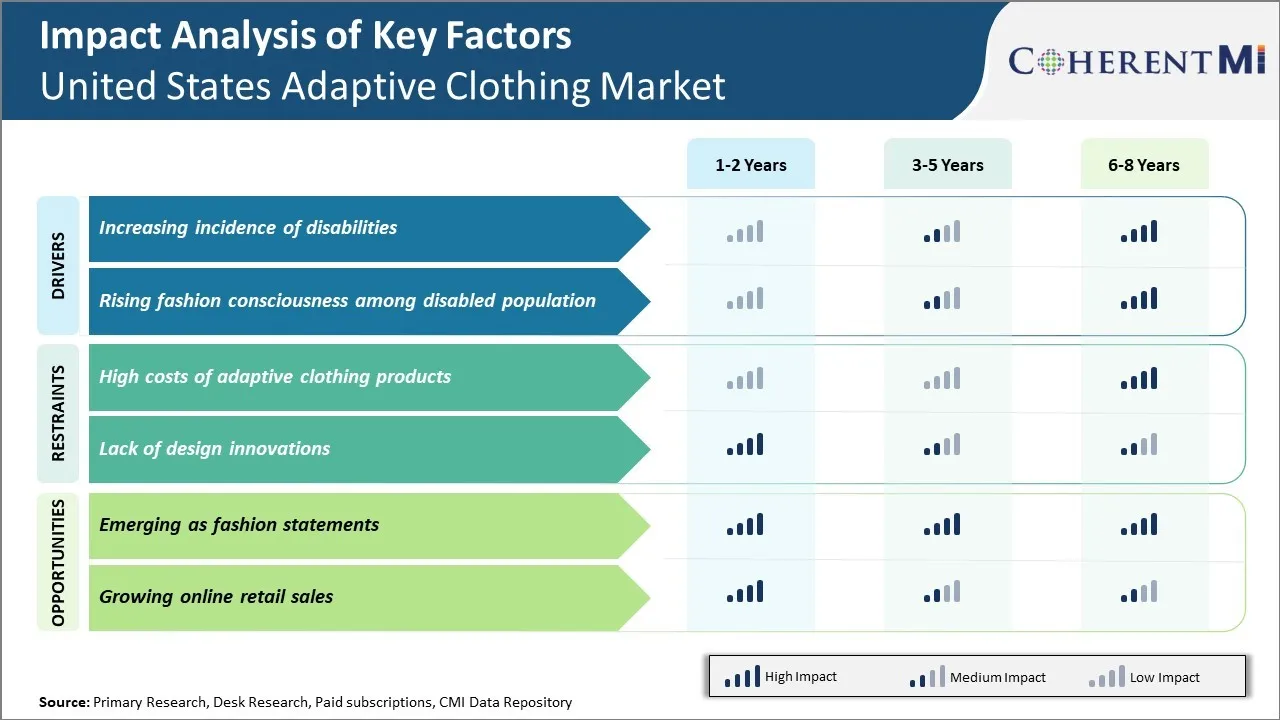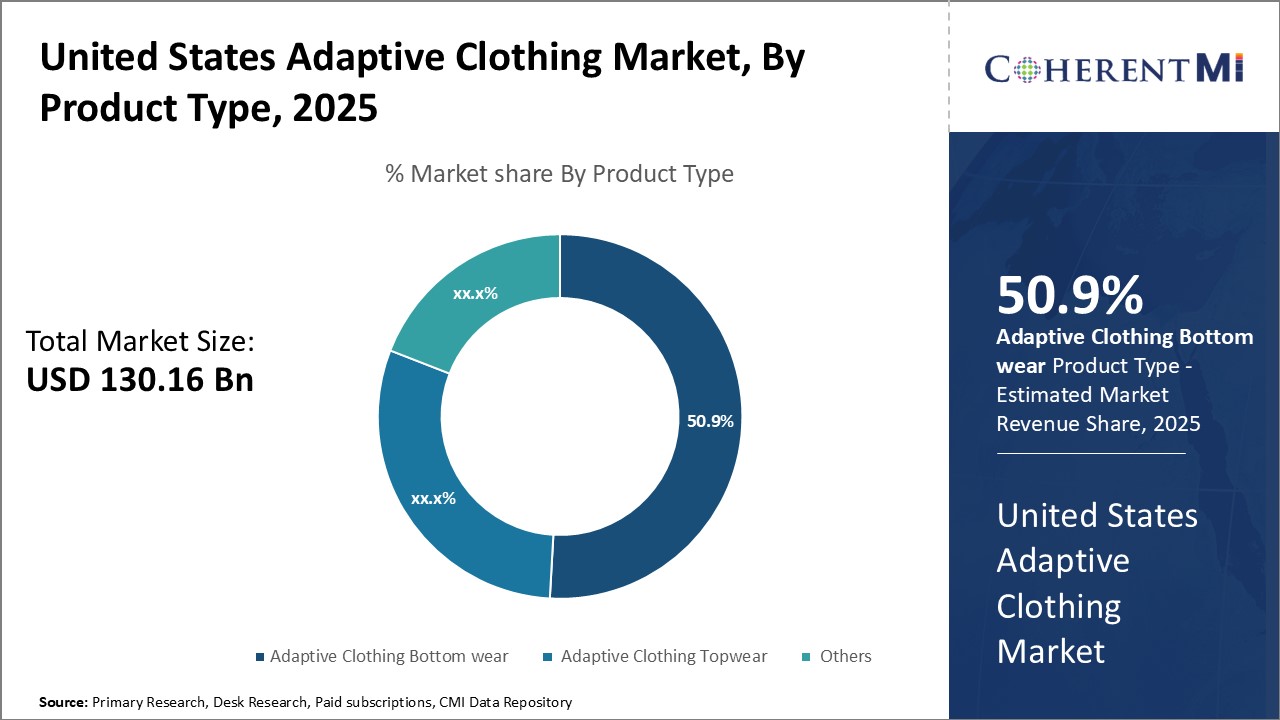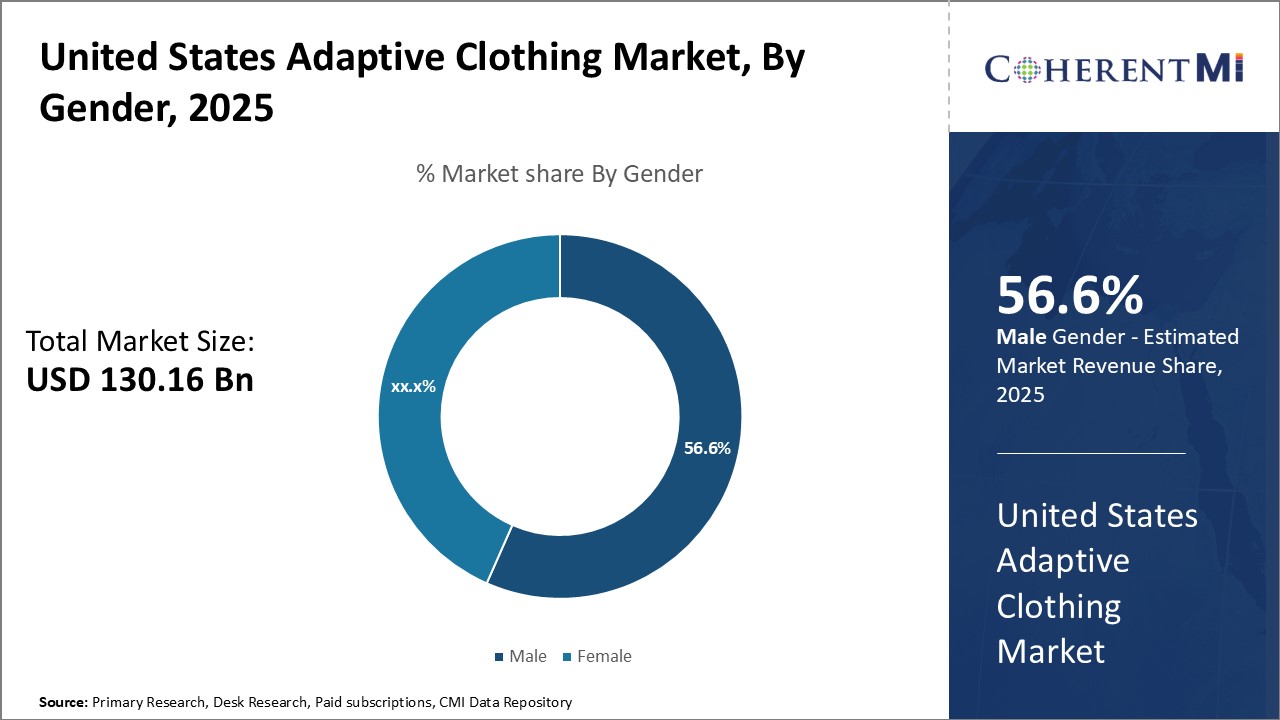United States Adaptive Clothing Market Size - Analysis
The United States Adaptive Clothing Market is estimated to be valued at USD 130.16 Bn in 2025 and is expected to reach USD 180.72 Bn by 2032, growing at a CAGR of 4.8% from 2025 to 2032.
Market Size in USD Bn
CAGR4.8%
| Study Period | 2025-2032 |
| Base Year of Estimation | 2024 |
| CAGR | 4.8% |
| Market Concentration | High |
| Major Players | Silvert’s Adaptive Clothing & Footwear, Izzy Camilleri, NBZ Apparel International, PVH Corp, Lycra Company and Among Others |
please let us know !
United States Adaptive Clothing Market Trends
The increasing incidence of disabilities in the United States is a major factor fueling the growth of the adaptive clothing market. As per data from the Centers for Disease Control and Prevention, over 61 million American adults were living with some form of disability in 2019, which translates to about 26% of the total US population. Of these, mobility disability was the most prevalent type affecting nearly 13% of adults.
The growing fashion consciousness among people with disabilities in the US is having a significant impact on the adaptive clothing market. As individuals with disabilities are more active, visible and assertive about their rights and needs, they are also expressing their personal style through fashion choices now more than ever before. There is a growing desire among disabled population to dress fashionably and not be limited by their condition or mobility challenges alone.

Market Challenge – High Costs of Adaptive Clothing Products
Moreover, unlike standard clothing, adaptive garments cannot be mass produced to benefit from economies of scale. Their market demand is also limited owing to the relatively smaller customer base of people with disabilities and medical conditions. This restricted volume further diminishes prospects of bringing down costs through large-scale manufacturing. Due to high pricing, many low-income individuals have to compromise on their dignity and ability to dress independently.
Market Opportunity – Emerging as Fashion Statements
As adaptive clothing gains acceptance as a valid fashion niche, the customer base is expanding beyond just those with medical or physical needs. Mainstream fashion followers interested in the latest styles are driving significant demand for adaptive looks that are not just functional but attractive. Stylish designs, inclusive sizing, innovative fabrics and thoughtful features allow everyone to enjoy on-trend adaptive outfits. According to a 2020 study by United Spinal Association, nearly 80% of disabled adults surveyed said they would purchase adaptive clothing more frequently if a wider variety of fashionable designs were readily available.
Segmental Analysis of United States Adaptive Clothing Market
 Insights, By Product Type: Adaptive Clothing Bottom Wear Drives Product Segment Growth
Insights, By Product Type: Adaptive Clothing Bottom Wear Drives Product Segment GrowthIn terms of product type, adaptive clothing bottom wear sub-segment contributes the highest share of 50.9% in the United States adaptive clothing market owing to several key demand drivers. Adaptive bottoms see extensive usage given the practical challenges posed by disabilities in performing daily lower body motions. The tailored design of adaptive pants and shorts catering to needs such as easy accessibility, adjustable waist and leg bands, and anti-chafe fabrics see strong popularity. Furthermore, adaptive bottoms allow individuals to focus on upper body motions with confidence in lower body support and comfort.

Insights, By Gender: Male Segment Dominates Adaptive Clothing Market by Gender
The willingness to experiment and adopt new styling or technological adaptations in bottom wear and other garments is also relatively greater among males. This has encouraged clothing brands to prioritize innovations tailored to male preferences. The functional and modest styles preferred by many males pair well with discreet yet effective disability-specific clothing adaptations. Furthermore, the male segment exhibits brand loyalty to adaptable clothing companies catering to their diversity of needs. With consistent demand drivers, the male consumer category leads the market share in the gender segment of the United States adaptive clothing industry.
Competitive overview of United States Adaptive Clothing Market
The major players operating in the United States Adaptive Clothing Market include Able2Wear, Adaptions by Adrian, Professional Fit Clothing, Adaptive Clothing Showroom, Creation Confort, Silvert’s Adaptive Clothing & Footwear, Izzy Camilleri, NBZ Apparel International, PVH Corp, and Lycra Company.
United States Adaptive Clothing Market Leaders
- Silvert’s Adaptive Clothing & Footwear
- Izzy Camilleri
- NBZ Apparel International
- PVH Corp
- Lycra Company
United States Adaptive Clothing Market - Competitive Rivalry

United States Adaptive Clothing Market
(Dominated by major players)
(Highly competitive with lots of players.)
Recent Developments in United States Adaptive Clothing Market
- In September 2022, Kohl’s (an American department store retail chain, operated by Kohl's Corporation) expanded its adaptive merchandise assortment with the launch of adaptive products for adults. The collection was designed in partnership with Gamut Management, a consulting and talent Management Company for people with disabilities, per a company press release. Kohl’s already offers adaptive products for kids, including apparel from its Jumping Beans, Tek Gear, SO and Sonoma Goods for Life labels and toys from brands including Helping Hands Fine Motor Tool Set Toy and Foxmind Go Pop! Roundo.
- In September 2021, LYCRA Company, a global leader in innovative solutions for stretch and performance technologies for the apparel industry, launched LYCRA ADAPTIVfibre breakthrough technology. This fiber allows garments to have a better fit for various lifestyles, movements, and provide better fit as per the different body types.
- In March 2021, Tommy Hilfiger announced the launch and addition of Tommy Hilfiger Adaptive collection for Spring 2021 to its adaptable apparel collection for adults and children with disability.
United States Adaptive Clothing Market Segmentation
- By Product Type
- Adaptive Clothing Bottom wear
- Adaptive Clothing Topwear
- Others
- By Gender
- Male
- Female

Would you like to explore the option of buying individual sections of this report?
Sakshi Suryawanshi is a Research Consultant with 6 years of extensive experience in market research and consulting. She is proficient in market estimation, competitive analysis, and patent analysis. Sakshi excels in identifying market trends and evaluating competitive landscapes to provide actionable insights that drive strategic decision-making. Her expertise helps businesses navigate complex market dynamics and achieve their objectives effectively.
Frequently Asked Questions :
How big is the United States Adaptive Clothing Market?
The United States Adaptive Clothing Market is estimated to be valued at USD 130.16 in 2025 and is expected to reach USD 180.72 Billion by 2032.
What are the major factors driving the United States Adaptive Clothing Market growth?
The increasing incidence of disabilities and rising fashion consciousness among disabled population are the major factors driving the United States Adaptive Clothing Market growth.
Which is the leading Product Type in the United States Adaptive Clothing Market?
The leading Product Type segment is Adaptive Clothing Bottomwear.
Which are the major players operating in the United States Adaptive Clothing Market?
Able2Wear, Adaptions by Adrian, Professional Fit Clothing, Adaptive Clothing Showroom, Creation Confort, Silvert’s Adaptive Clothing & Footwear, Izzy Camilleri, NBZ Apparel International, PVH Corp, and Lycra Company are the major players.
What will be the CAGR of the United States Adaptive Clothing Market?
The CAGR of the United States Adaptive Clothing Market is projected to be 4.8% from 2025-2032.